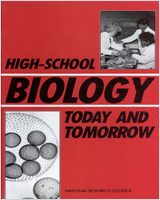NCBI Bookshelf. A service of the National Library of Medicine, National Institutes of Health.
Biology is where many of science's most exciting and relevant advances are taking place. Yet, many students leave school without having learned basic biology principles, and few are excited enough to continue in the sciences. Why is biology education failing? How can reform be accomplished? This book presents information and expert views from curriculum developers, teachers, and others, offering suggestions about major issues in biology education: what should we teach in biology and how should it be taught? How can we measure results? How should teachers be educated and certified? What obstacles are blocking reform?
Contents
- COMMITTEE ON HIGH-SCHOOL BIOLOGY EDUCATION
- BOARD ON BIOLOGY
- COMMISSION ON LIFE SCIENCES
- [The National Academies]
- PREFACE
- PART I. OPENING ADDRESS AND RESPONSES
- 1. Opening Address
- 2. Changing Conceptions of the Learner: Implications for Biology Teaching
- 3. Literacy, Numeracy, and Global Ecology
- 4. All Is for the Best in the Best of Possible Worlds."
- 5. The Scientific Revolution in Medicine: Implications for Teachers of High-School Biology
- 6. High-School Biology Training: A Prospective Employer's View
- PART II. OBJECTIVES OF BIOLOGY EDUCATION AND MEASUREMENT OF ACHIEVEMENT
- 7. Issues in Objectives and Evaluation
- 8. Assessing Student Understanding of Biological Concepts
- 9. The Advanced-Placement Biology Examination: Its Rationale, Development, Structure, and Results
- 10. The Development of Interest in Science
- 11. What High-School Juniors Know about Biology: Perspectives from NAEP, the Nation's Report Card
- 12. The NABT-NSTA High-School Biology Examination: Its Design and Rationale
- PART III. CURRICULUM: PERSPECTIVES AND CONTENT
- PART IV. INSTRUCTIONAL PROCEDURES AND MATERIALS
- 17. To Weed or to Cultivate—Which?
- 18. Biology Learning Based on Illustrations
- 19. Teaching High-School Biology: Materials and Strategies
- 20. A New Kind of Museum of Natural History as an Instrument of Informal High-School Education in Biology
- 21. Messing about in Science: Participation, Not Memorization
- PART V. TEACHER PREPARATION
- 22. Biology Teacher Education: Panacea or Pitfall
- 23. Professional Teachers for High-School Biology
- 24. Biology Teacher Training: Preparing Students for Tomorrow
- 25. Standards for the Preparation and Certification of Biology Teachers
- Introduction
- Uses of Teacher Preparation and Certification Standards
- The Great Debate
- Implementation of Professional Standards
- NSTA's Program to Certify Individual Science Teachers
- Alternative Certification Programs—Good News and Bad News
- Quo Vadis? Issues to Be Addressed and Resolved
- References
- Appendix A NABT Biology Teaching Standards
- Appendix B Standards for the Preparation and Certification of Secondary School Teachers of Science
- 26. Current Issues in Biology Education for Teachers
- PART VI. ACCOMPLISHING CURRICULAR CHANGES—INSTITUTIONAL BARRIERS
- PART VII. ACCOMPLISHING CURRICULAR—IMPLEMENTATION
Support for the publication of these papers was provided by the Howard Hughes Medical Institute, Bethesda, Maryland.
NOTICE: The project that is the subject of this report was approved by the Governing Board of the National Research Council, whose members are drawn from the councils of the National Academy of Sciences, the National Academy of Engineering, and the Institute of Medicine. The members of the committee responsible for the report were chosen for their special competence and with regard for appropriate balance.
This report has been reviewed by a group other than the authors according to procedures approved by a Report Review Committee consisting of members of the National Academy of Sciences, the National Academy of Engineering, and the Institute of Medicine. The National Academy of Sciences is a private, nonprofit, self-perpetuating society of distinguished scholars engaged in scientific and engineering research, dedicated to the furtherance of science and technology and to their use for the general welfare. Upon the authority of the charter granted to it by the Congress in 1863, the Academy has a mandate that requires it to advise the federal government on scientific and technical matters. Dr. Frank Press is president of the National Academy of Sciences.
The conference High-School Biology: Today and Tomorrow was organized by the Board on Biology of the National Research Council's Commission on Life Sciences. The views in this book are solely those of the individual authors and are not necessarily the views of its sponsors.
Papers from a conference held Oct. 1988, in Washington, D.C.
- NLM CatalogRelated NLM Catalog Entries
- The revitalization of U.S. dental education.[J Dent Educ. 2008]The revitalization of U.S. dental education.DePaola DP. J Dent Educ. 2008 Feb; 72(2 Suppl):28-42.
- The Japanese science education centers.[Science. 1966]The Japanese science education centers.Glass B. Science. 1966 Oct 14; 154(3746):221-8.
- [A proposal for reforming psychologists' training in France and in the European Union].[Encephale. 2009][A proposal for reforming psychologists' training in France and in the European Union].Bouchard JP. Encephale. 2009 Feb; 35(1):18-24. Epub 2008 Apr 2.
- Review Anatomy of a successful K-12 educational outreach program in the health sciences: eleven years experience at one medical sciences campus.[Anat Rec. 2002]Review Anatomy of a successful K-12 educational outreach program in the health sciences: eleven years experience at one medical sciences campus.Burns ER. Anat Rec. 2002 Aug 15; 269(4):181-93.
- Review Special education for intellectual disability: current trends and perspectives.[Curr Opin Psychiatry. 2009]Review Special education for intellectual disability: current trends and perspectives.Kauffman JM, Hung LY. Curr Opin Psychiatry. 2009 Sep; 22(5):452-6.
- High-School Biology Today and TomorrowHigh-School Biology Today and Tomorrow
Your browsing activity is empty.
Activity recording is turned off.
See more...
